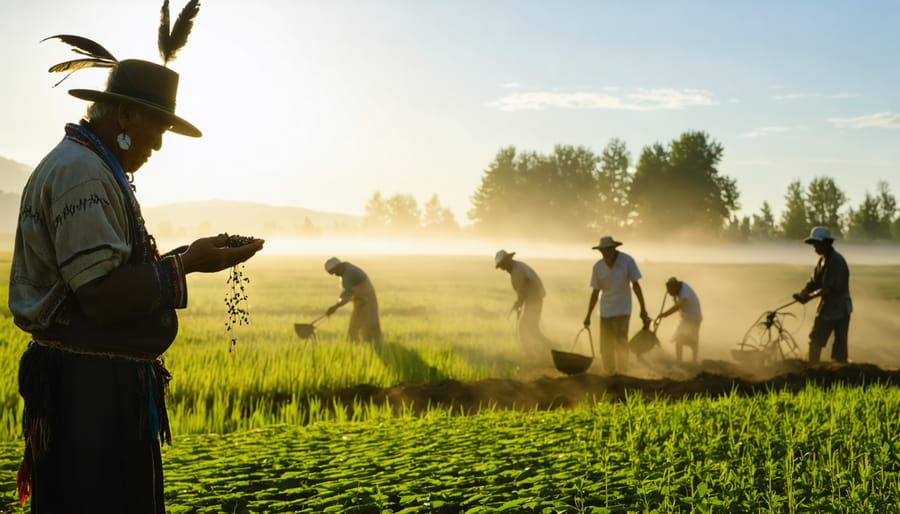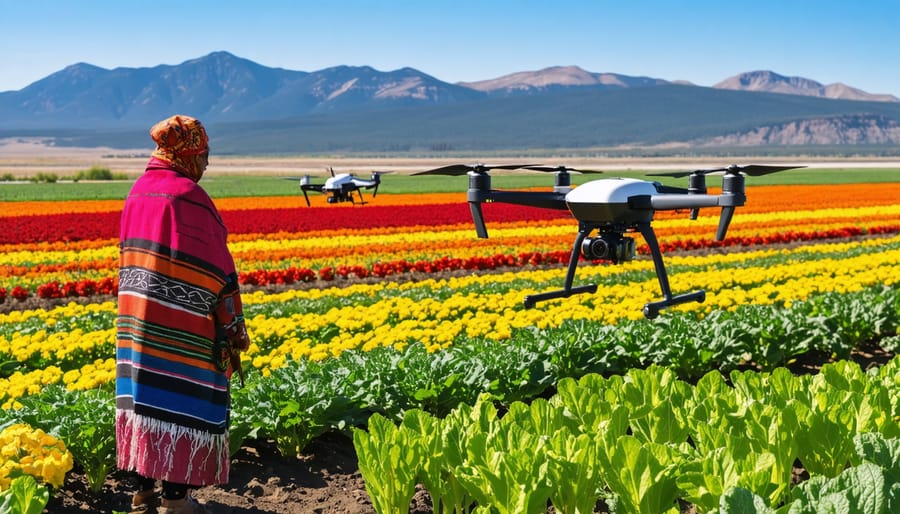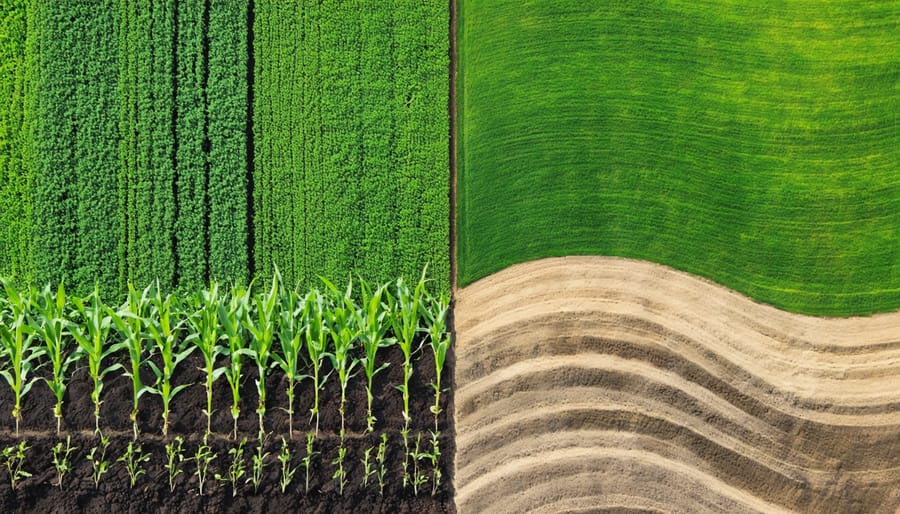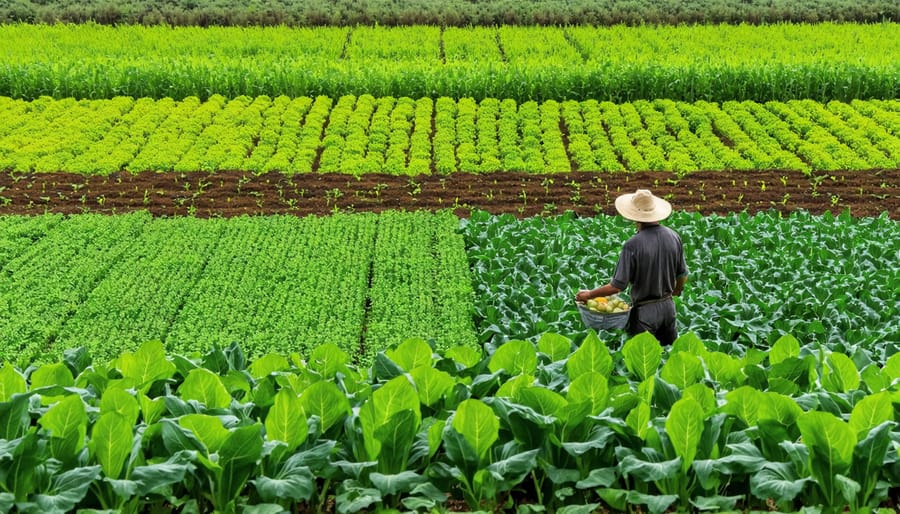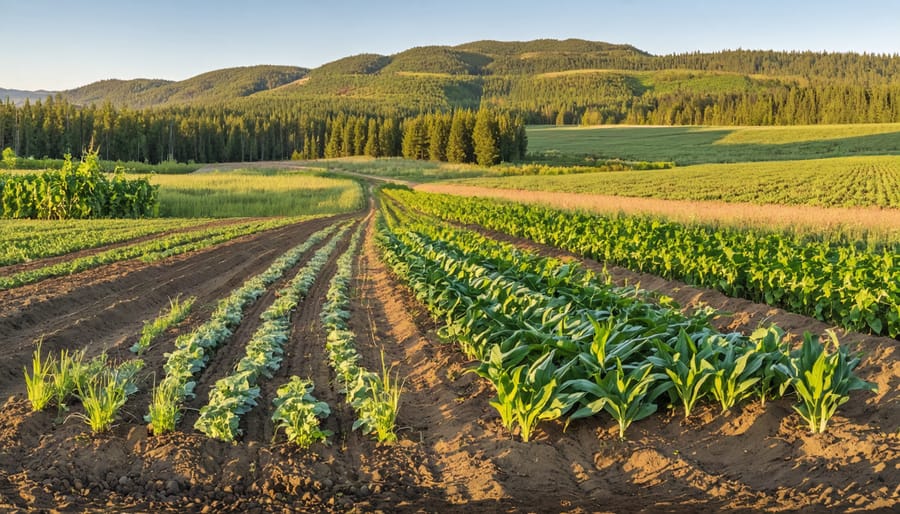Traditional Indigenous permaculture principles hold profound solutions for today’s agricultural challenges. For centuries, First Nations communities across Alberta have cultivated the land through sophisticated methods that maximize soil health while minimizing environmental impact. These time-tested practices, from companion planting to natural pest management, offer modern farmers practical strategies for building resilient, sustainable operations.
By integrating Indigenous agricultural wisdom with contemporary farming techniques, Canadian producers are discovering powerful ways to enhance crop yields, reduce input costs, and strengthen their connection to the land. The Three Sisters method of planting corn, beans, and squash together demonstrates how traditional knowledge can improve soil fertility naturally, while Indigenous water management techniques help farmers adapt to changing climate patterns.
These ancestral farming practices aren’t just historically significant—they’re proving invaluable for addressing current agricultural challenges across the prairies. From the Medicine Wheel Gardens’ teachings about crop rotation to traditional seed saving methods, Indigenous agricultural knowledge offers practical solutions for building more sustainable, productive farming operations while honoring the land’s cultural heritage.
Traditional Planting Ceremonies That Honor the Land
The Sacred Spring Blessing
For many Indigenous communities across Alberta, the Sacred Spring Blessing ceremony marks the vital transition from winter to the growing season. This pre-planting ritual, traditionally held when the first thunders are heard, serves both spiritual and practical ecological purposes. Elder Mary Yellowhorn of the Piikani Nation explains that the ceremony involves offering tobacco and prayers while observing natural indicators that signal optimal planting conditions.
The ceremony encourages farmers to pause and carefully assess environmental conditions before planting. Participants observe soil temperature, moisture levels, and the emergence of specific plants that indicate winter’s end. This traditional knowledge aligns remarkably well with modern sustainable agriculture practices, as it prevents premature planting that could lead to crop failure.
During the blessing, community members gather to share knowledge about local weather patterns, soil conditions, and seed varieties best suited to the region. This collective wisdom, passed down through generations, has helped Indigenous farmers maintain successful harvests while preserving soil health and biodiversity.
Today, several farming cooperatives in Alberta incorporate elements of the Spring Blessing into their pre-planting routines. The ceremony reminds us that agriculture is not just about production, but about maintaining a respectful relationship with the land. As noted by agricultural scientist Dr. Sarah Thompson, these traditional practices often reveal sophisticated understanding of local ecosystems that can enhance modern farming methods.
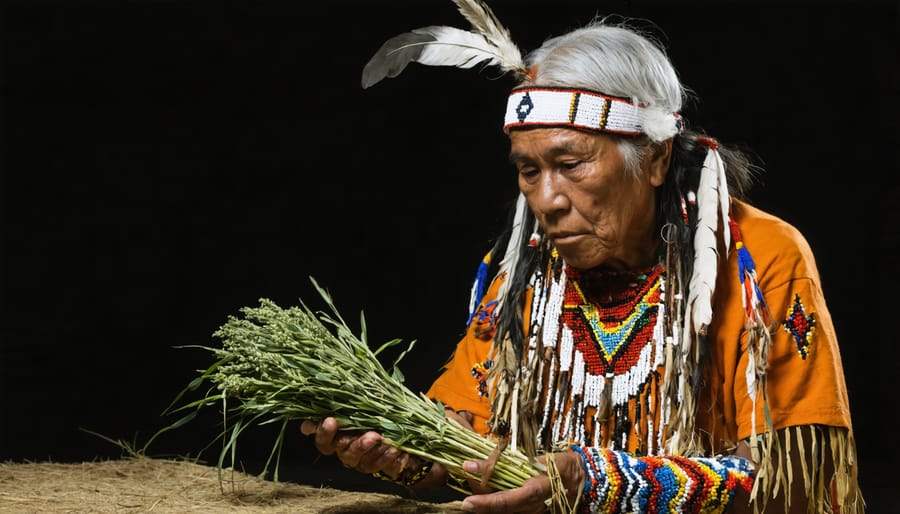
Moon Phase Planting
The practice of planting by moon phases has been a cornerstone of Indigenous agricultural wisdom for generations across Alberta’s diverse landscapes. Many First Nations communities, including the Blackfoot and Cree, traditionally time their planting activities according to lunar cycles, a method that modern science is beginning to validate.
The basic principle involves planting above-ground crops during the waxing moon phase (from new moon to full moon) when the moon’s gravitational pull is believed to draw moisture upward in both soil and plants. Root crops are typically planted during the waning phase, as decreasing moonlight is thought to encourage downward growth and root development.
Research conducted at the University of Alberta has shown that seeds planted during the waxing moon phase often demonstrate higher germination rates and stronger early growth. This aligns with traditional knowledge that suggests the moon’s influence on Earth’s water movements affects plant development.
Local farmer Marie Running Wolf, who implements moon phase planting on her mixed farm near Red Deer, reports consistently better yields with this method. “Our ancestors understood these natural rhythms,” she explains. “When we align our planting with these cycles, we work with nature rather than against it.”
To implement moon phase planting, farmers can use readily available lunar calendars and combine this knowledge with modern weather forecasting for optimal results. This integration of traditional wisdom with contemporary farming practices offers a sustainable approach that honours Indigenous knowledge while potentially improving crop outcomes.
Harvest Rituals That Protect Soil Health
The First Harvest Offering
In many Indigenous communities across Alberta, the First Harvest Offering represents more than just a ceremony – it’s a profound reflection of sustainable agricultural practices that have endured for generations. This traditional practice embodies a holistic approach to farming, where Indigenous crop rotation methods are intertwined with spiritual and cultural significance.
The ceremony typically occurs when the first crops reach maturity, marking a crucial moment in the agricultural calendar. Before any harvest begins, communities gather to offer thanks and acknowledge the earth’s abundance. This practice naturally encourages farmers to observe their crops closely, promoting better timing for harvest and deeper understanding of soil conditions.
What makes this tradition particularly relevant for modern farming is its emphasis on soil conservation. The ceremonial practices often coincide with careful crop selection and rotation planning for the next season. Traditional knowledge holders teach that certain crops should be planted together or in sequence, while others need time to rest – principles that align perfectly with contemporary sustainable agriculture.
In practice, this means allowing portions of fields to regenerate while others are cultivated, incorporating cover crops, and timing harvests to minimize soil disruption. Many Alberta farmers who have adopted these principles report improved soil health and reduced erosion, particularly in areas prone to wind damage.
The tradition also emphasizes the importance of saving seeds from the strongest plants, creating resilient, locally-adapted crop varieties. This practice of seed saving and selective breeding continues to influence modern organic farming methods throughout the province.
Community Harvest Celebrations
In Alberta’s farming communities, traditional Indigenous harvest celebrations offer valuable lessons in sustainable agriculture and community building. These gatherings, which historically marked successful growing seasons, demonstrate how collective farming efforts can enhance biodiversity and strengthen social bonds.
The Blackfoot people’s traditional harvest ceremonies, for instance, emphasize the interconnectedness of crops, showing how different plant species support each other’s growth. Modern farmers in the Lethbridge area have adapted these principles by organizing community harvest events where neighbouring farms share equipment, labour, and knowledge while celebrating their collective achievements.
Sarah Running Wolf, an Indigenous agricultural expert from Southern Alberta, explains, “These celebrations aren’t just about gathering crops – they’re about understanding how our farming practices impact the entire ecosystem. When we harvest together, we share stories about which companion plants worked well, which soil practices yielded the best results, and how wildlife interactions affected our crops.”
Several Alberta farming cooperatives now host seasonal harvest festivals that incorporate traditional Indigenous practices. These events typically feature seed exchanges, demonstrations of intercropping techniques, and discussions about preserving heirloom varieties. Participating farmers report increased crop diversity and stronger community networks as direct benefits of these collaborative approaches.
The Growing Together Initiative, launched by farmers near Red Deer, exemplifies this community-based approach. Their annual harvest gathering brings together Indigenous elders, local farmers, and agricultural students to share knowledge about sustainable farming methods while celebrating the season’s yields. This combination of traditional wisdom and modern farming practices has led to improved soil health and increased biodiversity across participating farms.
Modern Applications in Alberta Farms
Three Sisters Companion Planting
The Three Sisters planting method, a time-honored Indigenous agricultural practice, continues to prove its worth in modern farming systems across Alberta. This companion planting technique combines corn, climbing beans, and squash in a mutually beneficial relationship that maximizes soil health and crop yields while incorporating natural pest management practices.
In this system, tall corn stalks provide natural trellises for climbing beans, while the beans fix nitrogen in the soil, benefiting all three crops. The broad squash leaves create a living mulch that retains soil moisture and suppresses weed growth. This integrated approach typically yields 20% more produce per hectare compared to modern monoculture methods.
Local farmer Sarah Running Bear from Sturgeon County has successfully adapted this technique for commercial-scale production. “We’ve modified the traditional spacing to accommodate modern machinery, using 75-centimetre row spacing while maintaining the fundamental principles,” she explains. “The results have been remarkable – we’ve reduced our irrigation needs by 30% and virtually eliminated the need for synthetic fertilizers.”
To implement the Three Sisters method effectively in Alberta’s climate:
– Plant corn when soil temperatures reach 15°C
– Wait until corn reaches 15 centimetres before adding pole beans
– Introduce squash seedlings one week after the beans
– Space mounds 1.2 metres apart for optimal growth
Modern adaptations include using drought-resistant corn varieties and timing plantings to account for Alberta’s shorter growing season. Some farmers have successfully incorporated cover crops between rows, further enhancing soil health and biodiversity.
This traditional method demonstrates how Indigenous agricultural wisdom can effectively address contemporary farming challenges while promoting sustainable land stewardship.
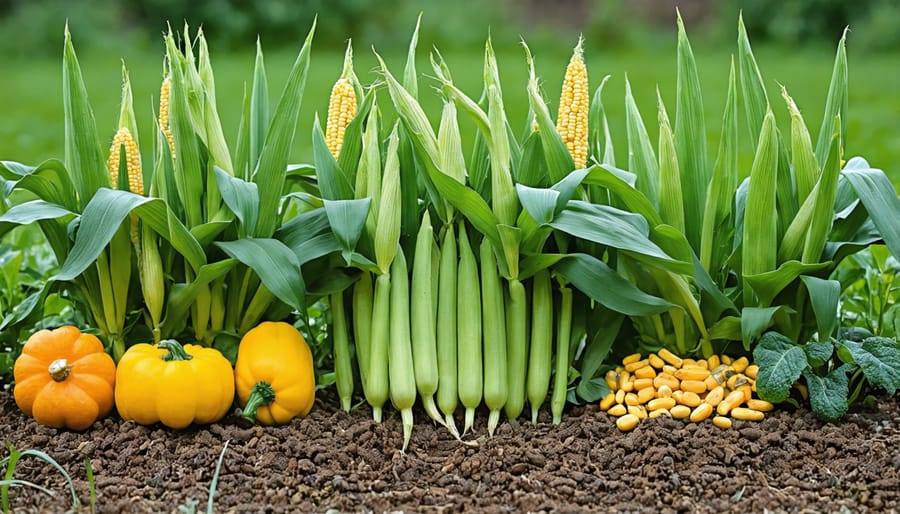
Water Conservation Through Traditional Methods
Indigenous communities across Alberta have long understood the delicate balance between water conservation and agricultural success. Today, many farmers are discovering the remarkable effectiveness of traditional water management techniques that have sustained crops for generations.
In the Bow River Valley, farmers are implementing Indigenous-inspired check dams and retention ponds, similar to those historically used by Blackfoot communities. These systems slow water flow during spring melt, allowing for greater soil absorption and reduced erosion. Local farmer Sarah Thompson reports a 30% reduction in irrigation needs since adopting these methods on her 200-hectare farm.
The practice of companion planting, derived from Indigenous Three Sisters methodology, naturally retains soil moisture. Corn provides shade, while squash’s broad leaves act as living mulch, reducing evaporation and maintaining soil humidity. This technique has proven particularly effective in southern Alberta’s semi-arid conditions.
Modern interpretations of traditional swale systems are gaining popularity among Alberta farmers. These shallow, contoured channels follow natural land patterns to capture and direct rainfall, mimicking the water-harvesting techniques historically used by Indigenous peoples. When combined with native plant species, these systems can reduce water usage by up to 40% compared to conventional irrigation methods.
Knowledge keepers from Treaty 7 territories have been instrumental in sharing insights about reading natural water indicators and timing planting cycles with seasonal water patterns. This wisdom, when integrated with current farming practices, helps producers make more informed decisions about water usage and crop timing.
By embracing these time-tested methods, Alberta farmers are not only conserving water but also building more resilient agricultural systems that can better withstand climate variations while honoring the agricultural heritage of the land’s first stewards.
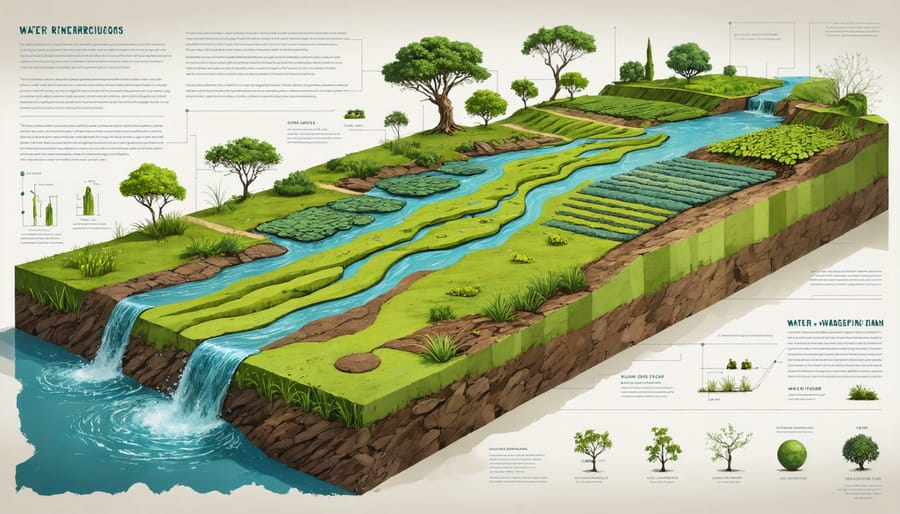
As we look to the future of Canadian agriculture, the integration of Indigenous farming practices with modern techniques offers a powerful path forward. The wisdom accumulated over thousands of years by Indigenous peoples provides valuable insights into sustainable land management, crop diversity, and ecological balance that can enhance our current farming systems.
By incorporating traditional methods like companion planting, natural pest management, and water conservation techniques, Alberta farmers have reported improved soil health and reduced input costs. These practices not only benefit the environment but also contribute to farm resilience and long-term sustainability. The success stories from farms across the province demonstrate that Indigenous agricultural knowledge can effectively complement modern farming technologies.
The integration of these practices has shown particular promise in addressing contemporary challenges such as climate change adaptation and soil degradation. Traditional methods of seed saving and crop rotation help preserve genetic diversity and maintain soil fertility, while Indigenous water management techniques offer valuable solutions for regions facing drought conditions.
Looking ahead, the partnership between Indigenous knowledge keepers and modern farmers creates opportunities for mutual learning and growth. This collaboration strengthens community bonds and promotes a more holistic approach to agriculture that considers both environmental and social impacts. Many Alberta farmers who have embraced these integrated approaches report not only improved yields but also a deeper connection to their land and local ecosystems.
The evidence is clear: when we combine the best of traditional Indigenous agricultural practices with modern farming methods, we create more resilient and sustainable food systems. This integration respects our agricultural heritage while embracing innovation, providing a blueprint for farming that can sustain future generations.
By continuing to learn from Indigenous agricultural wisdom and applying these principles alongside contemporary farming techniques, we can build a more sustainable and productive agricultural sector that honors both tradition and progress. The future of Canadian farming lies in this balanced approach, where ancient wisdom and modern innovation work together for the benefit of all.

